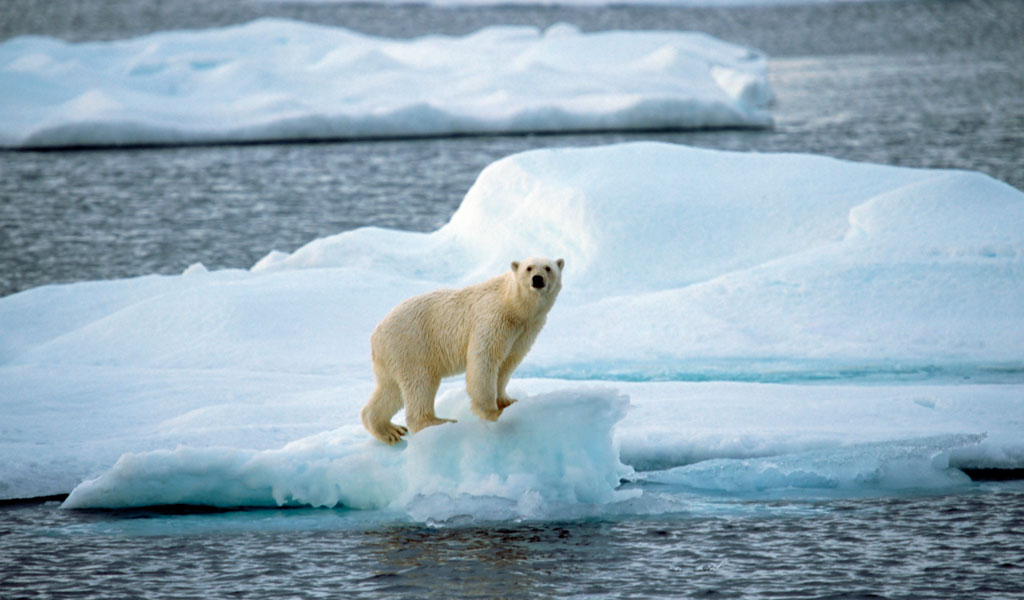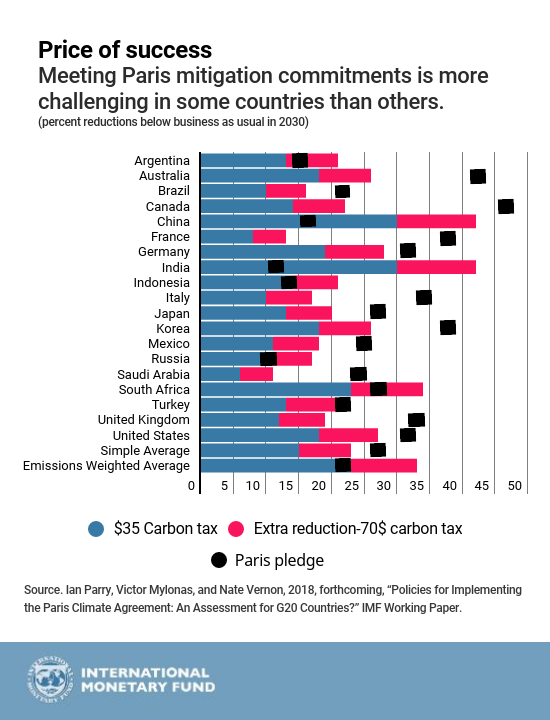June 8, 2018
Versions in عربي, 中文, Español, Français, 日本語, Português, Русский
[caption id="attachment_23636" align="alignnone" width="1024"] A polar bear on shrinking ice in the Arctic: climate change means the world is getting hotter (photo: Sven-Erik Arndt/Newscom)[/caption]
A polar bear on shrinking ice in the Arctic: climate change means the world is getting hotter (photo: Sven-Erik Arndt/Newscom)[/caption]
The world is getting hotter, resulting in rising sea levels, more extreme weather like hurricanes, droughts, and floods, as well as other risks to the global climate like the irreversible collapsing of ice sheets.
Here are five ways the IMF helps countries move forward with their strategies as part of their commitment to the 2015 Paris Agreement on Climate Change.
- Mitigate emissions. Carbon taxes, or similar charges for the carbon content of coal, petroleum products, and natural gas, are potentially the most effective instruments to reduce carbon dioxide emissions, the major source of heat-trapping gases. These taxes are straightforward to administer, for example, building off existing fuel excises, and can raise significant revenue for government that they might use to cut other burdensome taxes on the economy, or fund growth-enhancing investments.
The IMF provides practical guidance on the design of fiscal policy to mitigate climate change. We are developing spreadsheet tools to help countries gauge the emissions, and broader fiscal and economic impacts of carbon pricing, and the trade-offs across alternative mitigation instruments like taxes on individual fuels, emissions trading, and incentives for energy efficiency.
For example, our annual economic review for China showed that a carbon tax, or just a tax on coal use, would be significantly more effective at reducing carbon and local air pollution emissions than emissions trading systems which do not cover emissions from vehicles and buildings, and would also raise substantial revenue.
And according to our forthcoming working paper, a $70 price per ton on carbon dioxide emissions in 2030, which would increase gasoline prices by about 60 cents per gallon, and more than triple coal prices, would be more than sufficient to meet mitigation pledges in some advanced and emerging market economies like China, India, Indonesia, and South Africa. That price would be nearly sufficient in some other countries like Turkey and the United States, but well short of what Australia, Canada, and some European countries need.
These differences in the ability of the $70 price to meet mitigation pledges reflect both differences in the stringency of commitments, and in the responsiveness of fuels and emissions to pricing. For example, emissions tend to be more responsive to pricing in countries that use a lot of coal, like China, India, and South Africa.
- Energy subsidy reform. Pricing carbon should be part of a broader strategy to reflect the full range of social costs in energy pricing. This includes deaths from air pollution and other local environmental side effects from fuel use. A spreadsheet tool provides, for all member countries, estimates of the energy prices needed to reflect supply, and all environmental costs, as well as the implicit subsidies from underpricing fossil fuels.
According to IMF estimates, efficient energy pricing would have reduced global carbon emissions in 2013 by over 20 percent, and fossil fuel air pollution deaths by over 50 percent, while raising revenues of 4 percent of GDP.
IMF case studies of numerous countries’ reforms distill the ingredients for successful reform. One especially important ingredient is compensation for low-income households, which generally requires only a small fraction of the revenues generated from reform. We discuss energy price reforms as part of our annual review of a country’s economy, as well as in our technical assistance work with countries like Saudi Arabia , Jordan, United Arab Emirates, and in our courses and workshops.
Pricing carbon should be part of a broader strategy to reflect the full range of social costs in energy pricing.
- Build resilience. IMF staff have been assessing strategies for building resilience to climate and natural disaster risks, for example in Nicaragua, Myanmar, Zimbabwe and other especially vulnerable countries.
Climate Change Policy Assessments, so far conducted for Belize, Seychelles and St. Lucia, take stock of countries’ mitigation and adaption plans, risk-management strategies, and financing, and point to gaps where they need investment, policy changes, or help to build their capacity to address the effects of climate change.
IMF work is also helping to quantify the economic risks in vulnerable countries. For example, we estimate that the annual cost of natural disasters in low-income countries to be around 2 percent of GDP, or four times the impact on larger economies.
The IMF provides finance to help countries respond to the natural disasters and climate-related events. For example, during the 2015 Ebola crisis in West Africa, we established a trust fund to provide debt relief to poor countries hit by natural disasters. The IMF nearly doubled the amount countries can borrow following a large natural disaster.
- Greener financial sector. IMF staff analyze the ways in which climate risks impact financial stability. They also help identify best practices for stress tests to a country’s financial sector as a whole, which reflect climate risks. Various Financial Sector Assessment Programs , from small island states like Samoa to big economies such as the United States and France, have included stress tests to gauge the effects of natural disasters on insurance companies, banks, and other financial institutions.
- International action. IMF staff also recommend countries coordinate at the multilateral level for example by establishing a minimum price for carbon, to complement and strengthen the Paris process. IMF staff are also involved in developing proposals for the design of carbon taxes for international transportation fuels.
There are many dimensions to climate change, and we are addressing them across the entire institution in collaboration with the World Bank and other international organizations, in terms of policy analysis and advise and our capacity development work.
You can read more about the IMF and climate change here.







